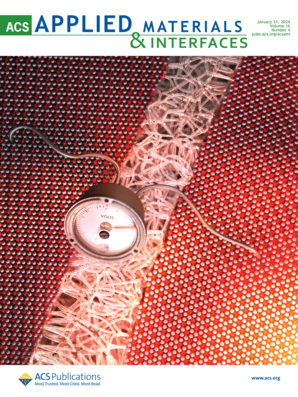基于深度共晶溶剂静电纺丝和硅模板刻蚀的木质素衍生分层多孔碳纳米纤维用于高性能超级电容器。
IF 8.3
2区 材料科学
Q1 MATERIALS SCIENCE, MULTIDISCIPLINARY
引用次数: 0
摘要
木质素是一种丰富的可再生资源,其价值增值对推进可持续材料创新至关重要。在此,我们提出了一种绿色和经济的策略来合成木质素衍生的分层多孔碳纳米纤维(HPCFs)。该方法利用氯化胆碱-乳酸深度共熔溶剂(ChCl-LA DES)溶解木质素,然后采用湿式静电纺丝法制备木质素基纤维气凝胶。将二氧化硅纳米球作为牺牲模板均匀嵌入电纺丝纤维中形成大孔,木质素碳化产生丰富的介孔和微孔,最终制备出具有多尺度孔隙结构的纳米碳纤维。此外,通过调节二氧化硅纳米球的含量可以调节碳纳米纤维的分层孔分布,从而优化碳纳米纤维的结构性能和电化学性能。优化后的碳纳米纤维中掺杂100 mg SiO2纳米球(100- hpcf),比表面积(779.515 m2/g)和比电容(237.1 F/g, 0.5 A/g)明显优于非模板木质素基电纺碳纤维(LESCFs)。此外,100-HPCF表现出优异的循环稳定性,在15000次循环后保持了97.7%的峰值电容。木质素增值、des处理和分层孔结构优化的整合为开发具有卓越超级电容器性能的先进碳材料建立了一条可持续和可行的途径。本文章由计算机程序翻译,如有差异,请以英文原文为准。
Lignin-Derived Hierarchically Porous Carbon Nanofibers via Deep Eutectic Solvent Electrospinning and Silica-Templated Etching for High-Performance Supercapacitors.
The valorization of lignin, an abundant and renewable resource, remains pivotal to advancing sustainable material innovation. Herein, we propose a green and cost-effective strategy for synthesizing lignin-derived hierarchically porous carbon nanofibers (HPCFs). This approach utilized choline chloride-lactic acid deep eutectic solvent (ChCl-LA DES) for lignin dissolution, followed by wet-electrospinning to fabricate lignin-based fiber aerogels. SiO2 nanospheres were uniformly embedded within electrospun fibers as sacrificial templates to create macropores, and the lignin carbonization generated abundant mesopores and micropores, ultimately producing carbon nanofibers with multiscale pore architectures. Furthermore, the hierarchical pore distribution can be tuned by modulating the SiO2 nanosphere content, which in turn optimized the textural properties and electrochemical performance of the carbon nanofibers. The optimized carbon nanofibers doped with 100 mg of SiO2 nanospheres (100-HPCF) exhibited distinct improvement in specific surface area (779.515 m2/g) and specific capacitance (237.1 F/g at 0.5 A/g), representing a marked improvement over nontemplated lignin-derived electrospun carbon fibers (LESCFs). Moreover, 100-HPCF demonstrated exceptional cycling stability, retaining 97.7% of its peak capacitance after 15000 cycles. The integration of lignin valorization, DES-enabled processing, and hierarchical pore-structure optimization establishes a sustainable and viable pathway for developing advanced carbon materials with exceptional supercapacitor performance.
求助全文
通过发布文献求助,成功后即可免费获取论文全文。
去求助
来源期刊

ACS Applied Materials & Interfaces
工程技术-材料科学:综合
CiteScore
16.00
自引率
6.30%
发文量
4978
审稿时长
1.8 months
期刊介绍:
ACS Applied Materials & Interfaces is a leading interdisciplinary journal that brings together chemists, engineers, physicists, and biologists to explore the development and utilization of newly-discovered materials and interfacial processes for specific applications. Our journal has experienced remarkable growth since its establishment in 2009, both in terms of the number of articles published and the impact of the research showcased. We are proud to foster a truly global community, with the majority of published articles originating from outside the United States, reflecting the rapid growth of applied research worldwide.
 求助内容:
求助内容: 应助结果提醒方式:
应助结果提醒方式:


